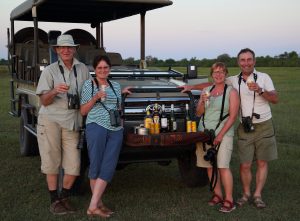Heading north from Maun, the long straight potholed tar road becomes an increasingly bumpy sandy track as we head deeper into the African ‘bush’, with numerous Ring-necked Doves, Red-billed Hornbills, Fork-tailed Drongos, beautiful Lilac-breasted Rollers and stunningly iridescent indigo and violet Burchell’s Starlings along the way. Once inside the vast Moremi Game Reserve, we enjoy plenty of interesting wildlife sightings including a male Black-bellied Bustard, the strutting Kori Bustard, a pair of sedately stalking Southern Ground Hornbills, several African Crakes, flocks of Helmeted Guineafowl, Egyptian Geese, Spur-winged Geese and Cattle Egrets, and the Coppery-tailed Coucal, a Zambezian endemic. By now the ever-narrowing ‘road’ is a mere dirt track, winding through the scrub, where numerous Swainson’s and Red-billed Spurfowl, use the tyre tracks as running lanes right in front of the vehicle, before reluctantly flushing sideways at the very last minute, as if playing a game of Chicken! As well as all the new birds, we see the first of many Elephants, plus Southern Giraffes, Burchell’s Zebra, Impala, Waterbuck, Greater Kudu, Warthog, Tree Squirrels, a handsomely marked Black-backed Jackal, and a mother White Rhino with a cute but not so little calf, and we haven’t even reached our first camp yet! Not bad for a travelling day.
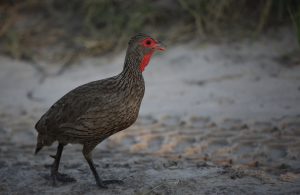
After dark, an orchestra of chirping insects plays under a billion stars in an inky black sky, fireflies dance around the camp fire, a Spotted Hyena nonchalantly creeps to within twenty yards of the dinner table, before silently fading away into the darkness, and our noisy Hippo neighbours bellow their double bass notes throughout the night.
This morning, our first ‘official’ game drive starts with Blacksmith and Long-toed Lapwings, Little Bee-eaters and busy Holub’s Golden Weavers, all barely thirty yards from camp, and we soon spot several smart Red Lechwes, an antelope which can only be seen in this part of Botswana! The next sighting is a distant resting Lioness and so our driver, Gaeboelwe Mange (Gee for short, with a laugh like a Spotted Hyena, and a fine set of teeth to match) changes track, on the trail of the Lion. Minutes later we drive into a pride of thirteen Lions, lying beside and across the track, just a few yards ahead of the jeep! The frequently yawning cats show no reaction to our presence, apart from one, which approaches to sprawl flat out in the shade of the jeep, while ‘our very own’ Barn Swallows sweep to and fro, just a few feet above the lazy pride. Fifty magical minutes pass before these African icons melt away into the bush at around 8.20am; wow!

Moving on, new sightings include Crowned Lapwing, Levaillant’s Cuckoo, Green Wood Hoopoe, African Grey Hornbill, Tawny Eagle, Meyer’s Parrot, Yellow-billed Hornbill and several soaring Bateleurs, while a Leopard Tortoise trundling along the track brings us to a momentary standstill. There seem to be birds everywhere, such as Red-billed Buffalo Weaver, African Openbill, Rattling Cisticola, Meves’s Starling, Southern Carmine and European Bee-eaters and the amazing Long-tailed Paradise Whydah. It’s now 9.30am and time for ‘elevenses’, under a massive Baobab tree, bearing the scars of damage from Elephants digging their tusks into the juicy bark. Back on ‘the road’, a small pool attracts numerous Spur-winged Geese, White-faced Whistling and Knob-billed Ducks, Red-billed Teal and a Squacco Heron. Along comes a Giraffe with several Yellow-billed Oxpeckers hitching a ride on its neatly patterned neck, followed by Magpie Shrike, African Jacana, Emerald-spotted Wood Dove, Dark-capped Bulbul, high flying Collared Pratincoles and the smart Broad-billed Roller. Even back at camp, we are still finding new birds like African Paradise Flycatcher and the tiny Grey-backed Camaroptera.
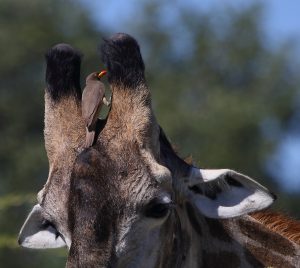
This afternoon, we begin with loads of jostling, grumpy, pugnacious Hippos, playing host to Red-billed Oxpeckers, and then a couple of Black Crakes amongst a dozen or so African Jacanas, with a pair of African Fish Eagles overseeing the action in the crowded waterway, where we also spot a five foot long Water Monitor. The damp green margins to the watercourses are home to hundreds of Red Lechwe, along with Wood Sandpiper and an Okavango Hinged Terrapin (Is there anything that Gee doesn’t know about this amazing place?). Next sighting is the Grey Go-away Bird, with a Mohican hairstyle, and at the next waterhole, there are hundreds of Collared Pratincoles, dozens of Ruff and Water Thick-knees, a couple of Three-banded Plovers and Black-winged Stilts, a sunbathing Nile Crocodile, a Fish Eagle stripping a fish carcass, a Cape Wagtail, and a Common Sandpiper riding on the back of a Hippo! Further new sightings include Zitting Cisticola, Senegal and Black Coucals, Red-capped Lark, African Stonechat and a good looking Reedbuck starring at us from its bushy hideout. By early evening, as the shadows lengthen, we find another Lioness, roaring to its hidden pride members, until a second Lioness appears, with a group of twenty plus Elephants in the opposite direction, making a nice composition against the glowing sunset. What a fabulous day. Lions roaring in the near distance during the night show what an untamed wilderness this is, and we have it all to ourselves!
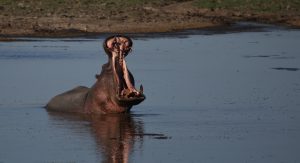
The daily routine begins at 5.30am with a friendly “Knock knock” wakeup call from the camp crew, bringing warm water to the tent for a wash, before breakfast at six. Setting off in the jeep just before seven, we begin with another Black-backed Jackal and an impressive trio of Kori Bustards, followed by a Fish Eagle watching from the top of a ‘sausage’ tree. Further new birds include Hammerkop, Greenshank, Black-winged Kite, Crimson-breasted Shrike, Banded Martin, Amur Falcon and a posing Black-chested Prinia, while new mammals include a large group of Vervet Monkeys and four Tsessebe Antelope. By 8.45am we are ready for a tea break, next to an old dead tree, with the twittering chicks of both Red-billed Hornbill and Burchell’s Starling inside different crevices, while a Brown Snake Eagle circles nearby. Moving on, Woodland Kingfisher, Bearded Woodpecker, Blue-cheeked Bee-eater and a magnificent pair of rare Wattled Cranes are all new for the trip, while we also enjoy seeing Kori Bustard and Southern Ground Hornbill again and again. We’re welcomed back at camp with iced tea and refreshing moist towels, in time for lunch at 11am, followed by some free time to take a shower and relax around the camp, where we find Spotted Flycatcher, Collared Sunbird, a pair of Meyer’s Parrots, prospecting for a nesting cavity in an old tree, and at least seventeen Peter’s Epauletted Fruit Bats, including a mother clutching her pup close to her chest, while roosting beneath the canopy of a particularly dense tree. A closer view of the bats shows a light sandy colouration, a wide eyed ‘foxy’ stare and obvious white patches (epaulettes) on the ears.

After tea and cake at 3.30pm, the safari restarts at four, and within less than ten minutes we meet a group of seven enormous Hippos grazing in the sunshine, whereas they normally leave the water at night. A little further on, the reeds are alive with a selection of birds such as Little Bee-eater, Holub’s Golden Weaver, Pin-tailed Whydah, Fan-tailed Widowbird, Red-billed Firefinch and a vivid male Southern Red Bishop. Ironically, within minutes, we find the large web of an equally sizeable Golden Orb Web Spider, capable of catching and devouring firefinches and waxbills! Subsequent new sightings include Common Waxbill, Red-backed Shrike, Black-backed Puffback, Red-billed Quelea, Southern Black Tit, Gabar Goshawk, a couple of Wahlberg’s Eagles on a high perch, and a pair of Double-banded Sandgrouse, feeding quietly on the track immediately ahead of the jeep. After a big red sunset at 6.44pm, there’s still time for another pair of spectacular Wattled Cranes, before a drink around the camp fire and dinner at seven, followed by a final glass of wine around the camp fire while listening to the nocturnal sounds of the African bush. That’s another typical day on safari in Botswana.

Barely ten minutes after leaving camp 14 for the last time, we spot a Lioness in the distance. Driving over for a closer look reveals not one but fifteen Lions, half-heartedly testing the fitness of a small group of large Hippos, but the Lions soon lose interest and spread out over a wide area, in various relaxed poses; a definite trip highlight. After thirty minutes with the pride, we move on toward camp 8, our second camp of the trip, and a full day’s drive away at safari pace. Early sightings include Dickinson’s Kestrel, tearing into a small prey animal, such as the fabled Tiny Fat Mouse perhaps, and an African Harrier Hawk being seen off by a posse of Burchell’s Starlings, while subsequent new birds include Blue Waxbill and Red-breasted Swallow. Along the way, the dry sandy track passes numerous Hippo pools with lush margins, teeming with water birds, such as Little, Intermediate and Great Egrets, African Darter, Reed Cormorant, Hammerkop, Glossy Ibis, African Spoonbill, Three-banded Plover, Whiskered Tern, thousands of murmurating Collared Pratincoles, and a pair of exquisitely marked African Pygmy Geese, with Sacred Ibises, Grey, Black and Squacco Herons, Pied Kingfisher and Slaty Egret, a highly localised Zambezian endemic, all perched in the same dead tree! After a tea break with a pair of Swamp Boubous, we continue deeper into the delta, where more new sightings include delicate White-winged Terns and some real heavyweights; Yellow-billed, Saddle-billed and Marabou Storks, plus the mighty Goliath Heron, with a slow flapping flight and an awesome wingspan.
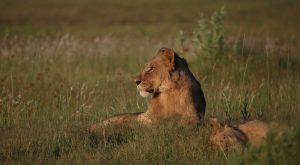
After lunch, a couple of over-flying Hooded Vultures open the afternoon list, before we arrive at the tiny settlement of Third Bridge, reached by a circuitous route, due to the Second Bridge falling into disrepair. At this point, a large lagoon attracts hundreds of Collared Pratincoles on their ‘winter holiday’ from Southern Europe, along with more of the usual suspects, plus Yellow-billed Duck, Hottentot Teal, Kittlitz’s Plover, Little Stint and Marsh Sandpiper. Further on, new birds include African Hoopoe, Hadeda Ibis and a camera shy Grey-headed Kingfisher, with numerous large, eye-catching African Monarch Butterflies along the way. By late afternoon, we are still finding new birds like Great Spotted Cuckoo, Sedge Warbler and White-breasted Cormorant. I don’t know how Gee does it, but after hours of driving on often imperceptible tracks, we arrive at camp 8 in an idyllic remote location next to a lagoon with Hippos, Crocodiles and birds like Blacksmith Plover, Pied Kingfisher and Goliath Heron, where the evening entertainment consists of star-gazing around the camp fire while listening to the usual insect chorus, accompanied by millions of pinging frogs and a calling African Barred Owlet, which eventually steals the ‘spotlight’. What a magical setting this is, with no one else for many miles.
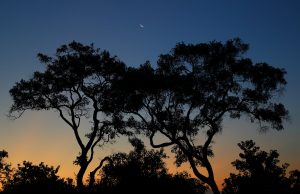
There’s a beautiful tranquil sunrise this morning, with Venus shining very bright, long after the stars have faded. During breakfast, a pair of Red-billed Spurfowl head purposefully for the kitchen area, hopefully to get fed on scraps, rather than ending up in the pot for dinner! We leave camp at 7am to take a boat ride at 7.30am, which is a thirty minute to one hour drive from camp, depending on how much we see along the way. Our boat actually leaves at 8am thanks to distractions en route from Purple Heron, a male Bennett’s Woodpecker foraging on the ground beside the track, a pair of roosting Verreaux’s Eagle Owls, with drowsy pink eyelids, a ‘frozen’, starring Bushbuck with a heart-shaped nose, and a tree ‘busy’ with Swallow-tailed Bee-eaters darting in and out, as well as Brubru, Long-billed Crombec and Chinspot Batis. We couldn’t have timed the boat trip better; less than ten minutes from the start, in the first narrow channel, we are confronted by an advancing bull Elephant, wading towards us and forcing the boat into reverse gear, as the massive beast continues his slow but purposeful advance, providing some spectacular photo-opportunities and an unforgettable experience. While the Elephant continues wading downstream, we resume course along the planned route. Cruising peacefully along tranquil clear channels, generously decorated with freshly blooming white water lilies, the numerous African Pygmy Geese prove camera shy in marked contrast to some very obliging subjects such as African and Lesser Jacanas, Malachite and Pied Kingfishers, Black Crake, and a Squacco Heron, totally unfazed by the boat alongside it at less than eight feet!
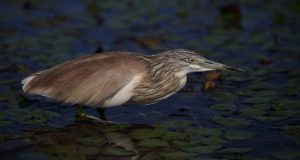
This afternoon there is plenty of time to watch the abundant birdlife around the camp, as the clouds accumulate into a heavy but brief downpour, with thunder and lightning. This afternoon’s game drive produces several highlights including a posing Goliath Heron, a Great Spotted Cuckoo, fleeing an unwelcoming party of Burchell’s Starlings, a drying creek full of water birds such as Marabou and Yellow-billed Storks by the dozen, as well as Saddle-billed and Woolley-necked Storks, Great and Little Egrets, Grey and Squacco Herons, African Spoonbill, Pied Kingfisher and Long-toed Lapwing, followed by another pair of Wattled Cranes, and a commotion caused by a couple of Slender Mongooses, involving several Go-away-Birds, Meves’s Starlings and Southern Black Tits, as well as a Crested Barbet and a Black-crowned Tchagra. Dinner is lamb chops and mash, rather than roast spurfowl, accompanied by red wine and the usual insect and frog ensemble, with an additional rendition by distant roaring Lions, followed by the now customary star gazing with a glass of wine around the camp fire.
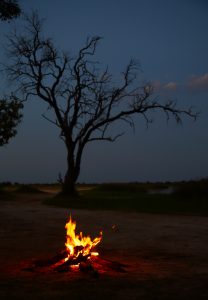
There’s another photogenic sunrise this morning, and by 6.45am we set off for Paradise Pools. Not only does Gee know all the ‘scenic routes’, through the mystifying mosaic of grasslands, woodlands and wetlands, but also the territories and family trees of individual Leopards! As the trusty ‘go anywhere’ Landcruiser bounces along with ease, despite the uneven sandy surfaces, Gee regularly looks down from behind the wheel to decipher the many different animal tracks, and try to work out the thinking behind the animals’ movements, bearing in mind the surrounding cover, wind direction and any nearby alarm calls, while also giving a running commentary on recent activity, and keeping the jeep on the track! Despite these remarkable skills, the elusive Leopard stays hidden this morning, and so we make do with close views of game like Cape Buffalo, Zebra, Impala, Red Lechwe, Elephant and a Hippo grazing well away from any water, while Retz’s Helmetshrike, African Green Pigeon, Purple Roller and White-backed Vulture are all new for the trip list.
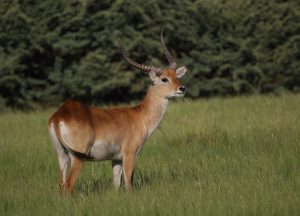
This afternoon’s game drive starts with African Purple Swamphen and African Marsh Harriers within sight of the camp. Next sighting is a pair of Wattled Cranes calmly preening at little more than fifty yards away, while spectacular forks of lightning crack through the distant dark grey clouds. As the passing storm gathers momentum most of the wildlife hunkers down until the weather settles down by late afternoon, when Southern White-crowned Shrikes suddenly seem to be everywhere. As the daylight wanes, a wonderfully atmospheric sunset develops, and as we photograph the spectacle, an African Snipe flies across the scene, and in case anyone misses it, it instantly flies back again! We have to be back in camp by seven and at 6.58pm, within a few hundred yards of the camp, Gee spots a female Greater Painted Snipe in the edge of the reeds! Back at camp the owlet is calling again beside the tents, and during dinner, a couple of Hippos graze within fifty yards of our table! That’s another remarkable end to another highly productive day.
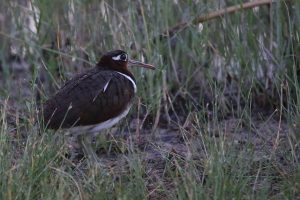
Sadly, it’s time to leave our fabulous camp, where the varied list of sightings is around forty species including White-breasted Cormorant, Sacred Ibis, White-faced Whistling Duck, African Barred Owlet, Malachite and Pied Kingfishers, Black-collared Barbet, Little Bee-eater, African Reed Warbler, Tawny-flanked Prinia, Hartlaub’s Babbler, Chinspot Batis, Brubru and White-crowned Helmetshrike. Setting off at 6.25am, the Painted Snipe is in exactly the same spot as we left her yesterday evening, along with Sedge and Lesser Swamp Warblers. Back in ‘paradise’ we strike lucky with a superbly attractive well grown Leopard cub, reclining on a thick branch, with its sinuous white-tipped tail flicking from side to side. It then decides to descend to the ground where we watch as it sits transfixed by a small group of nearby Impala, while occasionally inching closer in that classically feline stealthy manner. After half an hour of breathtaking activity, the young cat strolls past the front of the jeep, while the cameras whirr frantically. With the last, and most elusive of the ‘Big Five’ in the bag, (Rhino, Elephant, Lion, Buffalo and Leopard) we move on, full of excitement at such a privileged encounter. Shortly afterwards, a group of Crested Francolins, with tiny chicks, stands frozen in the middle of the track straight ahead of the jeep, forcing a halt until they come to their senses and scurry away into the bush. Whatever next? Well; a pack of twenty two African Wild Dogs, lazing in the shade in tight knit groups, while occasionally raising their heads, pricking their large ears and yawning, even though we are right beside them! A couple of the dogs decide to rouse themselves and trot towards some distant Impala, before returning to the shade, showing that each one has a unique marbled pattern. This is turning out to be a real ‘red letter day’ and a few minutes later we are watching three bull Elephants taking a shower in a pool beside the track! By late morning we reluctantly say goodbye to Moremi, with all its many highlights, and say hello to the adjacent Khwai region.
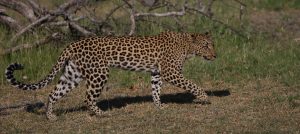
After a break for lunch in the shade, with numerous African Monarchs fluttering by, we find a Plain-backed Pipit on the aptly named Lechwe Plain, dotted with hundreds of these handsome antelope. Following the Khwai River, we watch a big bull Elephant dextrously wash clumps of water lily rhizomes, by swishing them in the water with his trunk before throwing them into his mouth, followed by a Little Grebe next to a big Hippo in a very small pool. Village Indigobird is the next new sighting, followed by the smart Rufous-bellied Heron, before we arrive at our next camp, called Mbudi, in another perfectly tranquil setting beside a narrow channel, blooming with white water lilies, where we count eighteen Openbilled Storks, pulling large snails out of the water. After dark, millions of pinging and tinkling frogs dominate the soundscape; just another day in ‘paradise’, with so many highlights, as well as a list of almost seventy five different birds!
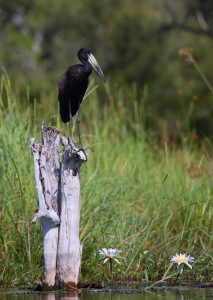
This morning, we have a short drive to rendezvous with some local boatmen, spotting Yellow-throated Petronia, a Pearl-spotted Owlet, with a hypnotically twitching tail, and a pair of African Hawk Eagles perched at the top of a dead tree along the way. Being punted along a quiet backwater in a narrow flat bottomed boat, known locally as a Mokoro, allows a frog’s eye view of the water lilies, and birds like African Jacana, African Darter, Little Bee-eater, Malachite and Pied Kingfishers, Chirping Cisticola, Red-backed Shrike, and plenty more Openbills, while Lesser Striped Swallow, Little Bittern and Black-crowned Night Heron are new for the trip. Whereas bouncing along a sandy track in the Landcruiser is like riding a galloping camel, drifting slowly along the calm waterways in a Mokoro is very relaxing, allowing very laid back birding, with a tendency to lull one to sleep, until we sight a huffing Hippo just downstream, forcing a prudent retreat!
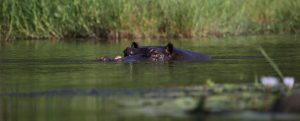
During the afternoon siesta, a herd of sixteen Elephants comes to within two hundred yards of the camp, just in time for afternoon tea! While drinking, showering and feeding on the opposite side of ‘our channel’, the Elephants provide us with some marvellous photo-opportunities. As we set off for the afternoon game drive, Gee asks us what we would like to see, and the unanimous response is “a male Lion please”. After ticking Cape Glossy Starling, which is new for the trip, our next wildlife encounter is with a pride of ten Lions, headed by two adult males! Forty minutes pass quickly as we watch the pride stroll from the shade of one bush to the next, with one tetchy battle-scarred male regularly snarling, growling and lashing out at the ‘ladies’, while the other is a perfect ‘gentleman’, showing his charm by nuzzling up to one of the ‘ladies’. Before we leave the pride, the handsome ‘gent’ walks purposefully toward the open-sided jeep and passes, within six feet of us, without so much as a sideways glance! Moving on, we aim for the edge of a large lagoon, to watch the sun go down with a G & T, while the Hippos bellow, Village Weavers attend their hanging nests, and Openbilled Storks fly in to roost, as Black-crowned Night Herons move in for the ‘nightshift’. Driving back to camp after dark, Scrub Hares are new for the trip. That’s another amazing day on safari in Botswana.
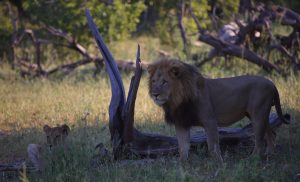
It’s a little chilly this morning, as the camp crew wave us off on another game drive, with their customary cries of “Later later later”. A busy waterhole, brimming with Spur-winged and Egyptian Geese, White-faced Whistling and Knob-billed Ducks and Blacksmith Lapwings, also produces another Painted Snipe and a Green-backed Heron, which is new for the trip. Bradfield’s Hornbill is also new, while other highlights this morning include another pair of Wattled Cranes, a troop of Chacma Baboons, with playful youngsters and grooming adults, and a small group of enormous and grumpy bull Cape Buffalo, while our return to camp for lunch is delayed by ten minutes or so due to an unforeseen Elephant ‘road block’!

This afternoon, we begin with a couple of Eurasian Golden Orioles, followed by a visit to a Spotted Hyena den, where two devoted mothers are busy looking after five really cute puppies, just twenty yards from the jeep, where the family goes about its business, unperturbed by our presence, allowing a privileged insight into the domestic lives of these gentle ‘brutes’. We arrive at Lechwe Plains in time for G & T’s as the sun goes down to produce a rosy wash in the west, enhanced by a passing chevron of Sacred Ibises. The night drive back to camp is packed with excitement, including four Scrub Hares, three Square-tailed Nightjars resting on the track, or perched on a dead branch, plus another Spotted Hyena. On the short track back to camp, Gee spots an African Wild Cat, even though it is well tucked into the adjacent bushes! His tracking and spotting skills are truly phenomenal. Minutes later we run into a young male Leopard, walking towards us along ‘our’ track ahead of the jeep. We shadow him in the spotlight as he silently stalks the bush. Last of all, we spot the eye shine of a Genet hidden deep in a bush, and an African Barred Owlet on a dead branch beside the track. Back at camp, the tinkling Painted Reed Frogs are on song again, ending another amazing day.
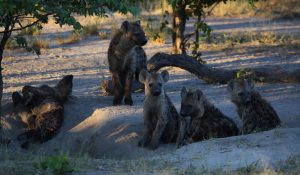
Breaking camp, we head north, with Elephants crossing the ‘highway’ ahead, leaving their wrinkled ‘dinner plate’ footprints in the soft sandy road surface. At the boundary with the immense Chobe National Park, Lion tracks show their recent passing, and further on, a termite mound in the middle of the ‘road’ is unmarked by any cones! Along the way, new birds include Yellow-billed Kite and a huge Lappet-faced Vulture perched in a dead tree along with several White-backs. By late morning the vast Mababe depression, a relict lake, dotted with thousands of Zebra and literally tons of Elephants, along with Giraffe, Blue Wildebeest, Impala and Tsessebe stretches to the distant horizon. New sightings here include Pied Babbler, European Roller, a roving group of Banded Mongoose and the rare, handsomely ‘face-painted’ Roan Antelope. After miles of soft sand in bouncy peaks and troughs, we arrive at Savuti in time for a picnic lunch under the shade of a large gnarly old Shepherd Tree, with a trunk thickly plastered with mud from passing Elephants, after a good scratch. Within shouting distance is a classic African scene, with herds of grazing Zebra and Wildebeest, browsing Giraffes, and mud-slinging Elephants, as well as a group of five Ostriches.
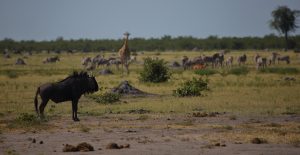
This afternoon’s highlights include a forest of legs created by a cluster of five quizzical looking Giraffes, two male Montagu’s Harriers, a Kori Bustard posing motionless just six yards from the jeep, and another Leopard Tortoise, this time motoring along the track ahead, before beetling off into the long grass. As we approach the next camp via the dry Savuti Channel, the first rock outcrop of the trip appears as a break to the normally ‘big sky’ horizon. Arriving at the camp in good time for a well-earned shower, we coincide with the ‘rush hour’ of a colony of foraging bees returning to their cavity in an adjacent tree. The bees quickly go wild for water around the wash tubs and shower heads, like wasps at a picnic, and so our showers have to wait until the bees have gone to ‘bed’!
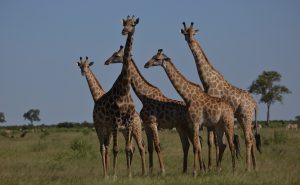
We have a full day to explore the beautiful green landscape of the vast Savuti Marsh, beginning with an exhilarating bouncy ride in the cool morning air, with early sightings of a Spotted Hyena on watch at her den, and a pair of black and grey Honey Badgers, crossing the track ahead of the jeep. You can wait a lifetime for a Honey Badger and then two turn up at once! Further sightings include a posing Black-chested Prinia, Marico Flycatcher, Lesser Kestrel, a Yellow Mongoose, standing up like a Meerkat, and a herd of impressive Eland, which are the largest of all the Antelope. I don’t think I have ever seen so many Giraffes anywhere, as in this open grassland landscape, which is also ideal for Botswana’s national bird, the Kori Bustard, and from one spot we count five of these stately birds, each with at least one Carmine Bee-eater riding on its back! The bee-eaters soon realise that following the jeep is more profitable than riding a bustard and we enjoy the challenge of photographing these exotic looking birds in flight as they hover and swoop down on large insects alongside us. After an exciting morning we stop for a tea break in the shade of a large tree, while an Ovambo Sparrowhawk repeatedly flies over us to land in its favourite tree.

Back at camp, the tents have been moved further from the bee colony, so that we can shower in peace. On the afternoon game drive we begin with a family of Ostriches; Mom, Dad and eight well grown hefty ‘chicks’. The next sighting is the head of our third Leopard of the trip, watching nearby Zebra from the long grass, before slinking away. Moving on we are still finding new birds like Desert Cisticola, Little Sparrowhawk and a croaking male Northern Black Korhaan. Back in the open grassland the jeep is again mobbed by numerous Carmine Bee-eaters darting down beside the jeep to catch disturbed insects, providing another entertaining challenge for the cameras, and a beautiful experience for the more laid back members of the group. By late afternoon, we have added Wattled Starling to our list of about seventy birds seen today, finishing off with a Verreaux’s Eagle Owl perched in an open canopy, and a displaying Red-crested Korhaan. After dinner, while sitting around the camp fire, a Spotted Hyena saunters through the camp!
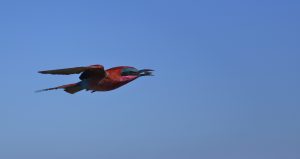
Fifteen minutes’ drive from camp, the first sighting of the day is a big male Kudu, with high spiralling horns and an attendant Yellow-billed Oxpecker, browsing a bush about six feet off the ground! Ten minutes later we find a small flock of Abdim’s Storks, followed by a Rufous-naped Lark singing from the top of a bush, and then male Shaft-tailed Whydah and Long-tailed Paradise Whydah on top of another bush.
As we leave wonderful Savuti, the light sandy track soon becomes deep red, and lined with pink-flowering Chobe Teaks, where a posing Dark Chanting Goshawk is the next new bird for the trip. After so many miles of narrow sandy tracks through the bush over the last ten days, it feels strange to be back on a tar road with road signs, including one warning of Elephants crossing, as we pass through a string of remote thatched hut villages, with cattle and goats roaming free. Pulling off the main road for a shady spot for lunch, within sight of the Caprivi Strip, an eastward-pointing finger of Namibia, we spot three new birds from the comfort of our camping chairs; African Golden Oriole, Fiscal Shrike and the gorgeous Orange-breasted Bushshrike.

Back on the main road, we soon re-enter Chobe National Park and revert to rough sandy tracks, overlooking the wide green floodplain of the meandering blue Chobe River, which forms the border with the Caprivi Strip of Namibia, barely fifty yards away, where today’s final new bird is the colourful Green-winged Pytilia. After dark, the only sound is from the chorus of insects, while lightning flashes silently on the horizon somewhere over the strip.
This morning’s drive begins with hundreds, if not a thousand or so, Cape Buffalo, heading down to the river. Thousands of hooves stir up their own dust cloud, so that the backlight of the sunrise creates a translucent haze around the herd, while restless flocks of Red-billed Queleas enhance the atmospheric scene. Further on, another two large herds of Buffalo, along with numerous Impala and Giraffe show just how much game there is here. Meanwhile, a large troop of Chacma Baboons, with play-fighting youngsters, keeps us entertained for a while, along with a small scurrying party of Banded Mongooses. As well as the usual water birds along the river, we also enjoy seeing a tree full of chattering Green Wood Hoopoes, a pair of Amur Falcons perched at the top of the same dead tree, flocks of clucking Helmeted Guineafowl, which always seem to be on the verge of a collective nervous breakdown, and finally a pair of Lanner Falcons, watching the floodplain from their tree top vantage points. Just before 9am, an old Lion with a thick black mane appears on the track ahead, purposefully patrolling the boundary of his territory by sniffing and scent-marking bushes alongside the track, while roaring furiously, so close to the jeep that the power of the sound reverberates through the human body! Wow; that’s definitely another highlight of the trip.
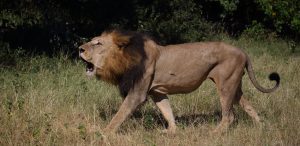
Our mid morning tea break is gate-crashed by a Vervet Monkey. On seeing his favourite Baker’s Romany Creams, he brazenly strides towards us, to calmly take the packet of out of Anny’s hand, as easily as taking candy from a baby! After this slow motion mugging, the ‘cheeky monkey’ retreats to a safe distance and stuffs the whole packet of biscuits into his bulging mouth, just like a pet hamster! Meanwhile, we can still hear the occasional Lion’s roar.
A mother Warthog and two piglets stroll past the tents during the afternoon’s rest! The first sighting on this afternoon’s drive is a posing Wattled Starling, followed by Greater Blue-eared Starling, which is new for the trip. The wide grassy flood plain is covered with a large mixed herd of Elephants and Buffalo, along with at least thirteen Giraffes clustered around a waterhole, with Squacco Herons, Little and Intermediate Egrets, African Jacanas, Whiskered Terns and a Saddlebilled Stork, all creating a very tranquil scene. Throughout the afternoon, there are plenty of Red-billed Queleas in murmurating flocks, and as the afternoon wanes, we enjoy watching a herd of sixty five plus Elephants silently grazing alongside the river, until one feisty young ‘buck’ creates a trumpeting hullabaloo, in a standoff with a Buffalo. This afternoon ends with a photogenic fireball sunset reflecting across the river. Botswana really is a photographer’s paradise.
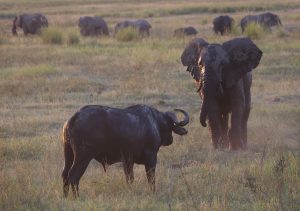
It’s sadly time to say a big thank you and farewell to the amazing camp crew, who looked after us so well throughout our safari, with supplies of warm water, cool drinks and excellent meals. Leaving Chobe National Park, we spot another new antelope on the way out; two rare, squirrel-red Pukus. By now we had covered hundreds of miles on narrow unmarked tracks, without the need for a map, thanks to Gee’s phenomenal familiarity with the region, in addition to his amazing tracking and spotting skills, giving us a spectacular and unforgettable journey.
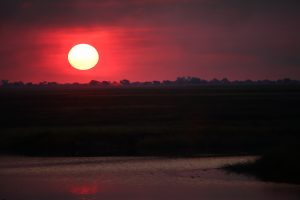
Back on the tar road, we follow signs for Kasane, a small border town, offering boat cruises on the Chobe River. Soon after boarding our own private cruise, White-crowned Lapwing at close range is new for the trip. By cruising slowly along, the wildlife accepts such a small boat at close range, producing super views of a variety of birds like African Darter, Reed Cormorant, Long-toed and Blacksmith Lapwings, Water Thick-knee, Green-backed Heron, White-winged Tern, Pied and Grey-headed Kingfishers, the Black Heron, which hunts in an umbrella stance, and wheezing Southern Red Bishops, as well as intimate views of numerous Elephants, enjoying mud showers and dust baths. The Crocodiles sunbathing on the river bank are equally confiding, allowing snaps from as little as eight feet, while one easily measures twelve feet in length!
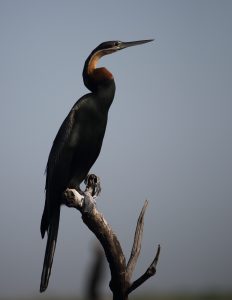
Back on dry land, we head for the nearby border crossing into Zimbabwe, and the sumptuous luxury of Ilala lodge in Victoria Falls. Even here on the outskirts of town, the hotel lawn is grazed by Warthogs and delicate white-spotted Chobe Bushbuck, and we even film a trio of young Elephants from our patios, peacefully browsing the bushes barely one hundred yards away!
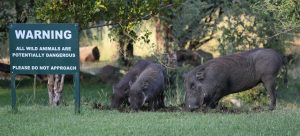
This morning we take a short stroll to the world famous Victoria Falls, one of the seven natural wonders of the world, where the mighty Zambezi plunges 354 feet into a mile wide gorge, with a continuous thundering roar, throwing clouds of spray sky high. The fallout from the spray creates a rainforest micro-climate home for large exotic butterflies in a range of colours, as well as a welcome cool shower for visitors. Alongside the awesome white water cataracts, new birds include Red-faced Cisticola, Red-winged Starling, Bronze Mannikin and Willow Warbler!
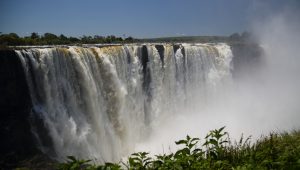
After a break for lunch and a dip in the pool, the birding continues around the lodge, where garden birds include Shikra, Laughing Dove, Wire-tailed Swallow, Brown-throated Martin, African Pied Wagtail, Tropical Boubou, Southern Black Flycatcher, Dark-capped Bulbul, Arrow-marked Babbler, Collared Palm Thrush, Jameson’s Firefinch, Village Indigobird and Village Weaver, bringing the bird count for the trip to 222, as well as some wonderful mammal sightings and many memorable highlights, with plenty of photos to prove it.

